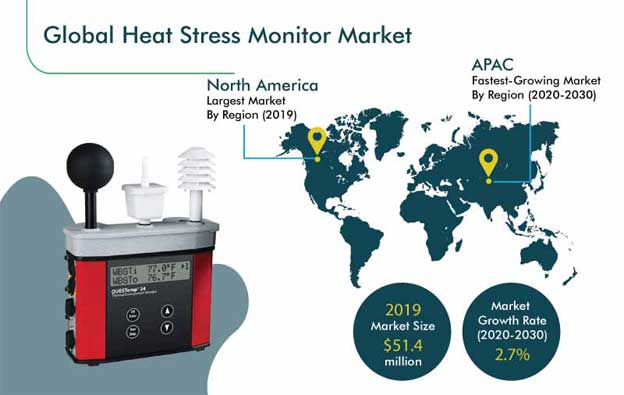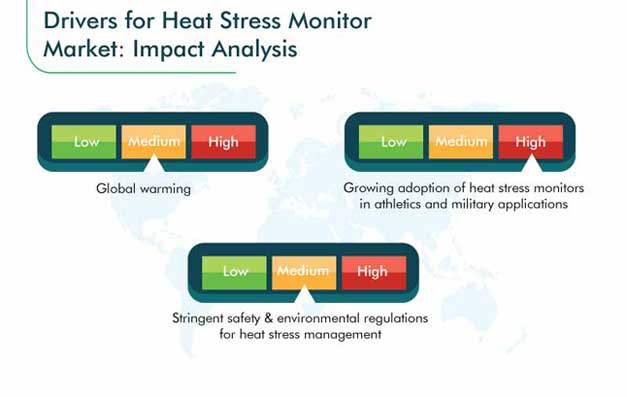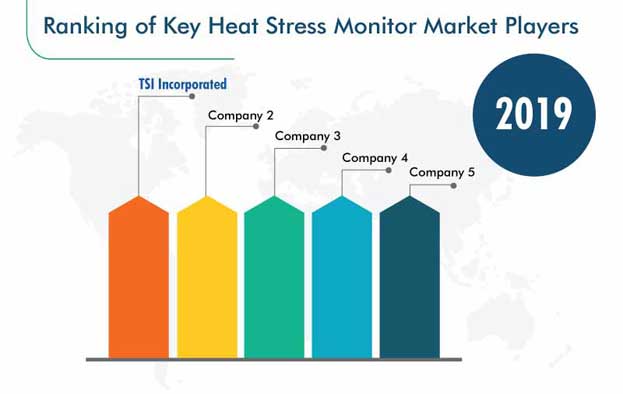Report Code: 12042 | Available Format: PDF | Pages: 138
Heat Stress Monitor Market Research Report: By Offering (Hardware, Software, Service), Technology (Wet Bulb, Dry Bulb), Product Type (Handheld/Portable, Fixed), Sensor Type (Globe Thermometer, Natural Wet Bulb, Dry Bulb, Humidity, Air Flow), Application (Athletics & Sport, Mining and Oil & Gas, Military, Manufacturing Plants)- Global Industry Analysis and Growth Forecast to 2030
- Report Code: 12042
- Available Format: PDF
- Pages: 138
- Report Description
- Table of Contents
- Market Segmentation
- Request Free Sample
Heat Stress Monitor Market Overview
The global heat stress monitor market size was $51.4 million in 2019, and it is projected to witness a CAGR of 2.7% during the forecast period (2020–2030). The growing awareness pertaining to heat-related illnesses, including heatstroke, fatigue, and dehydration, primarily for employees, athletes, and military personnel, is the key factor driving the heat stress monitor industry.
The COVID-19 pandemic has negatively impacted the growth of the heat stress monitor market across the world, as it has resulted in the disruption of the supply chain of raw materials and components. The disruption in the supply chain of components has impacted the original equipment manufacturers (OEMs) in China and other countries, which, in turn, has led to the declining global shipments.

Segmentation Analysis
Services Are Expected To See Fastest Increase in Demand during Forecast Period
In the heat stress monitor market outlook, on the basis of offering, the services category incorporates the revenue generated from the sale of aftermarket components, integration/deployment of heat stress monitor, and consulting services. With the rising adoption of heat stress monitors around the globe, the demand for installation and maintenance services is expected to increase rapidly during the forecast period.
High Adoption of Globe Thermometer Sensors Is owing to their Wide Applications
Globe thermometers, based on sensor type, are primarily used in mining and oil & gas applications, wherein a metal globe protects the sensor from external radiation and heat, and thus provides an accurate measure of the air temperature of the work environment. They are also being widely adopted in manufacturing plants, owing to their durable nature.
Growing Demand from Mining and Oil & Gas Industry Driving the Market Growth
The mining and oil & gas industry was the highest-revenue-generating category in the market, on the basis of application. Employees working in the mining and oil & gas industries are exposed to considerably hotter conditions when compared to other industries. Further, exposure to hot weather could lead to heat-related illnesses, such as heat exhaustion, rashes, cramps, and heatstroke.
Geographical Outlook
North America is Highest-Revenue-Generating Region due to Stringent Workplace Safety Regulations
North America dominated the heat stress monitor industry in 2019. Government organizations, such as National Institute for Occupational Safety and Health (NIOSH) and Occupational Safety and Health Administration (OSHA), have set mandatory guidelines for the safety of employees, pertaining to the exposure to heat. These mandatory standards have forced industries where the exposure to heat radiation is high, such as chemical, industrial manufacturing, mining and oil & gas, and petrochemicals, to use heat stress monitors. Further, the U.S., Canada, and Mexico are the host nations for the 2026 FIFA (Federation of International Football Association) World Cup, which would create a high demand for heat stress monitors, to improve the monitoring of athletes’ health during the tournament.
Asia-Pacific (APAC) To Witness Fastest Growth due to Growing Number of Manufacturing Plants
The growing number of manufacturing plants in the Asia-Pacific (APAC) region, majorly in developing countries such as India, Indonesia, Vietnam, Thailand, and China, is projected to drive the demand for heat stress monitor systems during the forecast period. Around 18% of the working populace in the region is employed in the manufacturing sector. In order to reduce the heat stress among employees, various governments have enacted occupational safety and health guidelines, which make it mandatory for companies to monitor the exposure to heat radiation and associated stress on employees.

Trends & Drivers
Wearable Heat Stress Monitors Are Key Market Trend
Wearable monitoring equipment and technological advancements in the field of heat stress monitoring are being observed as the key trends in the heat stress monitor market. For instance, innovative smart heat stress monitoring solutions by Qatar Mobility Innovations Center (QMIC), which are based on a smart internet of things (IoT) platform, provide automated systems for real-time heat stress monitoring of workers, to support occupational health and safety management efforts. This has enabled the protection of employees from heat-related illnesses.

Growing Demand for Heat Stress Monitors for Athletics and Military Application Is Driving Market Growth
Heat stress monitoring devices are being widely adopted in sports and military applications, due to the adverse effects of heat on individuals’ performance. Intense physical activities in operations and training exercises for prolonged durations expose military personnel and sports athletics to significant heat stress, due to the high ambient and metabolic heat production. Sports & athletics and military category are major contributors to the growth of the heat stress monitor market, as these instruments provide real-time monitoring of the health of sportspersons as well as military opersonnel in a training ground or field, alerting them about the heat stress limits, which is why they find high adoption in these industries.
| Report Attribute | Details |
Historical Years |
2014-2019 |
Forecast Years |
2020-2030 |
Base Year (2019) Market Size |
$51.4 million |
Forecast Period CAGR |
2.7% |
Report Coverage |
Market Trends, Revenue Estimation and Forecast, Segmentation Analysis, Regional and Country Breakdown, COVID-19 Impact, Company Share Analysis, Companies’ Strategical Developments, Product Benchmarking, Company Profiling |
Market Size by Segments |
By Offering; By Technology; By Product Type; By Sensor Type; By Application; By Region |
Market Size of Geographies |
U.S., Canada, Germany, France, Italy, U.K., Spain, Russia, Japan, China, India, Australia, South Korea, Brazil, Mexico, Saudi Arabia, South Africa |
Secondary Sources and References (Partial List) |
Centers for Disease Control and Prevention, European Agency for Safety and Health at Work, European Labour Authority, Global Oil and Gas Industry Trade Association, Institute of Electrical and Electronics Engineers, International Labour Organization (ILO), Mining Association of Canada, National Association of Manufacturers, National Center for Biotechnology Information, National Institute for Occupational Safety and Health of U.S., National Mining Association of U.S., Occupational Safety and Health Administration, Organisation for Economic Co-operation and Development (OECD) Note: Above listed references and organizations are partial; the detailed and complete list is available in the final report. |
Explore more about this report - Request free sample
Growing Focus Toward Heat Stress Management Is Boosting Market Advance
The growing awareness about illnesses caused due heat stress in workplaces, including manufacturing facilities, is another key factor propelling the heat stress monitor market growth. OSHA has set standards for workplace safety and monitoring workplace regulations. Similarly, the department/ministry of labor of various countries, including the U.S., Germany, Saudi Arabia, the U.K., Australia, India, South Korea, and Japan, have set strict guidelines about performing heat stress management at workplaces.
OEMs Focused on Geographical Expansion to Increase their Presence in Heat Stress Monitor Market
In recent years, players in the heat stress monitor industry have expanded to various high-growth locations, to stay ahead of their competitors. For instance:
- In October 2019,FLIR Systems Inc. announced its expansion in Virginia, U.S., by opening a new headquarters, which will also strengthen the company’s presence in Washington D.C. It will help the firm grow its business and create a new space to showcase the technology offered, primarily in the North American region.
Some of the Key Players Listed in Heat Stress Monitor Market Report Are:
-
TSI Incorporated
-
Romteck Australia Pty. Ltd.
-
REEDInstruments
-
Nielsen-Kellerman Co.
-
FLIR Systems Inc.
-
Narda Safety Test Solutions GmbH
-
General Tools and Instruments LLC
-
Industrial Scientific Corporation
-
PCE Instruments UK Ltd.
-
Sensidyne LPInstrumex
-
MISUMI Corporation
-
Air-Met Scientific Pty. Ltd.
-
Honeywell International Inc.
-
Gaugewear Inc.
-
Ambient LLC
-
Sato Keiryoki Mfg. Co. Ltd.
-
Hidalgo Ltd.
-
Fujitsu Ltd.
-
Inova Design Solutions Ltd.
-
Sper Scientific
-
Numag Data Systems Pvt Ltd.
-
Accutron Instruments Inc.
-
Svan Analytical Instruments Pvt. Ltd.
-
AZ Instrument Corp.
-
Runrite Electronics CC
-
Doculam Pty. Ltd.
Heat Stress Monitor Market Size Breakdown by Segment
The heat stress monitor market report offers comprehensive market segmentation analysis along with market estimation for the period 2014–2030.
Based on Offering
- Hardware
- Software
- Services
Based on Technology
- Wet Bulb
- Dry Bulb
Based on Product Type
- Handheld/Portable
- Fixed
Based on Sensor Type
- Globe Thermometer
- Natural Wet Bulb
- Dry Bulb
- Humidity
- Air Flow
Based on Application
- Athletics & Sport
- Mining and Oil & Gas
- Military
- Manufacturing Plants
Geographical Analysis
- North America
- U.S.
- Canada
- Europe
- Germany
- U.K.
- Italy
- France
- Spain
- Russia
- Asia-Pacific
- China
- Japan
- South Korea
- India
- Latin America
- Brazil
- Mexico
- Middle East and Africa
- Saudi Arabia
- South Africa
During 2020–2030, the heat stress monitor market will witness a CAGR of 2.7%.
The major contributors to the heat stress monitor industry advance are sportspersons, industrial workers, and military personnel.
North America was the largest region in the heat stress monitor market till 2019, whereas APAC will witness the highest CAGR during 2020¬–2030.
The segments covered in the heat stress monitor industry report include offering, technology, product type, sensor type, application, and region.
Geographical expansion is the most-significant strategic measure in the heat stress monitor market.
Want a report tailored exactly to your business strategy?
Request CustomizationWant an insight-rich discussion with the report author?
Speak to AnalystOur dedication to providing the most-accurate market information has earned us verification by Dun & Bradstreet (D&B). We strive for quality checking of the highest level to enable data-driven decision making for you
Our insights into the minutest levels of the markets, including the latest trends and competitive landscape, give you all the answers you need to take your business to new heights
With 24/7 research support, we ensure that the wheels of your business never stop turning. Don’t let time stand in your way. Get all your queries answered with a simple phone call or email, as and when required
We take a cautious approach to protecting your personal and confidential information. Trust is the strongest bond that connects us and our clients, and trust we build by complying with all international and domestic data protection and privacy laws
